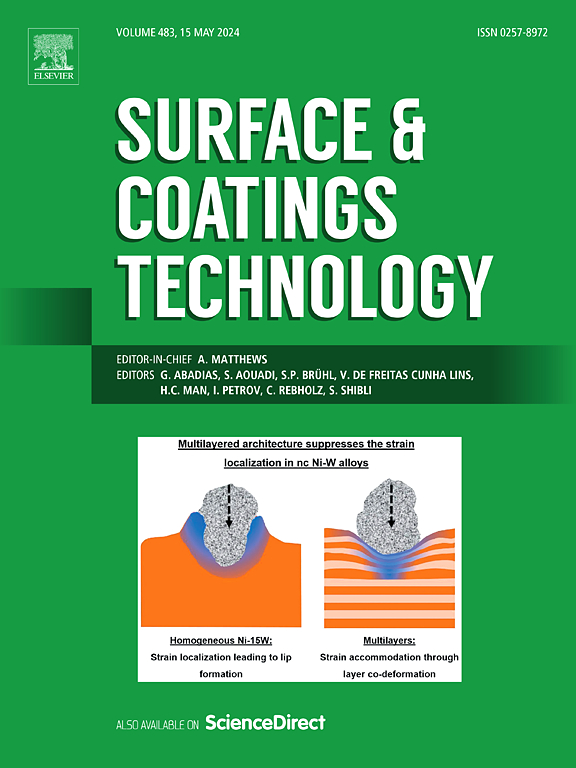Microstructural evolution and deposition mechanism of cold-sprayed Cr coatings on the Al and Ti substrates
IF 5.3
2区 材料科学
Q1 MATERIALS SCIENCE, COATINGS & FILMS
引用次数: 0
Abstract
Microstructural evolution and nanoindentation analyses were employed to investigate the deposition behavior of Cr particles on the Al and Ti substrates during cold spraying. The results indicate that substrate nanohardness plays an important role in determining both the thickness of the Cr coating and the bonding mechanism between the Cr particles and the substrates. In the initial coating layer, the rigid Cr particles are mechanically embedded into the softer Al substrate with minimal deformation, resulting in a dense and continuous coating composed of a few deformed particles. In contrast, deposition on the harder Ti substrate induces coordinated plastic deformation between the Cr particles and the substrate with mechanical interlocking; however, the resulting coating is discontinuous, exhibiting a thickness equivalent to a single deposited particle. The primary limitation in further increasing coating thickness arises during the stage of interaction between subsequent particles and the pre-deposited coating. Here, the uneven surface of the deposited layer reduces the effective impact velocity of incoming particles and, coupled with continuous work hardening, prevents synergistic plastic deformation with subsequent particles. Based on the observations of microstructural evolution and nanohardness distribution, the hypothesis regarding the formation mechanism of Cr coatings on the Al and Ti substrates is proposed.

Al和Ti基体冷喷涂Cr涂层的组织演变及沉积机理
采用显微组织演化和纳米压痕分析研究了冷喷涂过程中Cr颗粒在Al和Ti基体上的沉积行为。结果表明,基体纳米硬度对Cr涂层的厚度以及Cr颗粒与基体的结合机制起着重要的决定作用。在初始涂层层中,刚性的Cr颗粒以最小的变形机械嵌入到较软的Al衬底中,从而形成由少量变形颗粒组成的致密连续涂层。相反,在较硬的Ti衬底上沉积会导致Cr颗粒与衬底之间发生机械互锁的协调塑性变形;然而,所得到的涂层是不连续的,显示出相当于单个沉积颗粒的厚度。进一步增加涂层厚度的主要限制出现在后续颗粒与预沉积涂层之间的相互作用阶段。在这里,沉积层表面的不均匀降低了入射颗粒的有效冲击速度,加上连续的加工硬化,阻止了与后续颗粒的协同塑性变形。通过对Al和Ti基体的显微组织演变和纳米硬度分布的观察,提出了Cr涂层在Al和Ti基体上形成机理的假设。
本文章由计算机程序翻译,如有差异,请以英文原文为准。
求助全文
约1分钟内获得全文
求助全文
来源期刊

Surface & Coatings Technology
工程技术-材料科学:膜
CiteScore
10.00
自引率
11.10%
发文量
921
审稿时长
19 days
期刊介绍:
Surface and Coatings Technology is an international archival journal publishing scientific papers on significant developments in surface and interface engineering to modify and improve the surface properties of materials for protection in demanding contact conditions or aggressive environments, or for enhanced functional performance. Contributions range from original scientific articles concerned with fundamental and applied aspects of research or direct applications of metallic, inorganic, organic and composite coatings, to invited reviews of current technology in specific areas. Papers submitted to this journal are expected to be in line with the following aspects in processes, and properties/performance:
A. Processes: Physical and chemical vapour deposition techniques, thermal and plasma spraying, surface modification by directed energy techniques such as ion, electron and laser beams, thermo-chemical treatment, wet chemical and electrochemical processes such as plating, sol-gel coating, anodization, plasma electrolytic oxidation, etc., but excluding painting.
B. Properties/performance: friction performance, wear resistance (e.g., abrasion, erosion, fretting, etc), corrosion and oxidation resistance, thermal protection, diffusion resistance, hydrophilicity/hydrophobicity, and properties relevant to smart materials behaviour and enhanced multifunctional performance for environmental, energy and medical applications, but excluding device aspects.
 求助内容:
求助内容: 应助结果提醒方式:
应助结果提醒方式:


